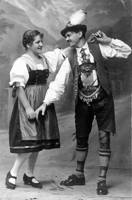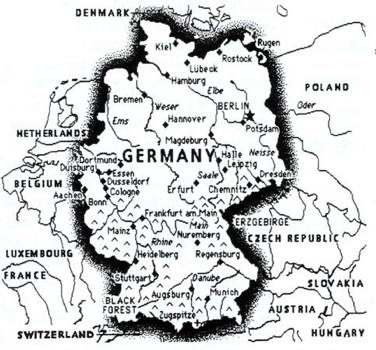
|
The Society of Folk Dance Historians (SFDH)
Choreogeography: Germany
[
Home |
About |
Encyclopedia | CLICK AN IMAGE TO ENLARGE |

|
BACKGROUND
Information: The Germany we know today did not exist before 1871 when Otto von Bismark thrust his will upon the many Teutonic-speaking peoples of Europe. From the multiple duchies, fiefdoms, townships, dukedoms, principalities and petty kingdoms, an empire was created, at once multi-faceted and united by a common thread and cultural personality that is distinctly German.
The nation's borders have been modified many times throughout its years of existence. Ambitious leaders have attempted to spread the empire's reach on three occasions, gaining and losing lands in the process. Bismark's beloved Prussia is now the northern part of Poland, but the influence of its disciplined, authoritarian culture influences the country to this day.
The northern third of the country is the coastal plain, flat and monotonous, easily traversed and strongly influenced by the cultures from Denmark, Holland, and Scandinavia. Much of the area's livelihood is from the sea or from the commerce and industry made profitable by proximity to ocean shipping and foreign markets.
 The dance and music of the north are very much in the style of the Danish and Dutch set dances with complex patterns requiring not so much vigorous technique, but a carefully synchronized set of figures, correctly executed by every member of the set. It reveals a strong interest in and aptitude for complex, skillfully created machinery, yet with a light, almost child-like and humorous air.
The dance and music of the north are very much in the style of the Danish and Dutch set dances with complex patterns requiring not so much vigorous technique, but a carefully synchronized set of figures, correctly executed by every member of the set. It reveals a strong interest in and aptitude for complex, skillfully created machinery, yet with a light, almost child-like and humorous air.
Germany is famous for the quality of its precision-made products and America owes much to the immigrants who have brought that skill and attitude to us and instilled it into America's culture.
The central third of Germany differs geographically from the coastal region in its low, rolling hills, creating a widely varied landscape. The land is fertile and agriculture is the major form of livelihood, creating a robust and earthy cultural personality. In this narrow strip is the state of Saxony, origin of the Saxons of both Britain, who faced the invading hoards of William the Conqueror, and Transylvania.
Walter Starkie, in his book "Raggle Taggle," tells of meeting a strange mean in his tramp through Transylvania in the late 1920s, who claimed to be the famous Pied Piper of Hamlin. He lead Starkie to the town of Hermanstadt, now Sibiu, where he claimed he had taken the abducted children long ago, now grown after several generations into the Saxons of that area. Starkie remarks about their tall, arrogant bearing and their utter contempt for their short, darker Romanian and Hungarian neighbors.
Indeed, German settlements were extended far to the east, into Russia and the Ukraine. Though most have been removed since World War II, some German villages still exist today in Hungary.
In the south lies the famous region of Bavaria, the Rhineland, and the now French-owned states of Alcase and Lorraine. Here are the famous Alps, some of the most beautiful scenery in the world and a culture most unique in Germany. The Bavarians have their own light-hearted, yet distinctly German outlook on life. High mountains are not conducive to rich agricultural soils and Bavaria is no exception. High mountain meadows provide summer grazing for milk cows and cheese is a regional specialty.
In this very rural region, the traditional folk arts remain the strongest and most well preserved. "Lederhosen" (short or knee-length leather breeches) and "dirndles" (traditional feminine dress) are not an unusual sight and many young men can still recall having a short pair of lederhosen for summer and a knee-length pair for winter. Many funny stories have been told about how a young man "roughed up" a new pair of lederhosen so that they did not look new &150; the grungier the better.
Each valley or region has its own style of lederhosen, identified by color, trim, or embroidery and whether the legs are rolled up or not. The women's dirndls are as distinct as the men's lederhosen, each region having its own style and color combinations.
The Schuhplattler is the most famous dance of Bavaria, indeed for the entire Tyrol into Austria and even northern Italy. The tradition is that the men mimic the ring-tailed growse. The cock beats his wings rapidly while strutting about and the hen replies by turning in spins in front of him. In the dance, the men beat rhythms with stamps and slaps on thighs and shoe-soles and the women spin around the men. The dance is a unique combination of earthiness, power, precision, and fun, danced with German dead-pan determination and exuberance.
The Zwiefacher, two things (pronounced SHVEE-fach-er), is another unique dance of Bavaria, but it has spread much further than the Schuhplattler into Austria, Bohemia, and Switzerland. Its mix of 3/4 and 2/4 rhythms creates a challenge to the dancers, who must execute the dance in a continuous spin, alternating Waltz and Dreher (pivot) steps to music that will sometimes camouflage the rhythms to confuse the dancers. The combinations are endless, but the dance again fulfills the German penchant for precision and discipline.
Germans love a celebration and they come in a bewildering variety of old and modern, religious and secular, local and national. Most famous, of course, is Munich's Oktoberfest, celebrated throughout the world, but nowhere as seriously as in Munich itself. The tradition began as the wedding celebration of King Ludwig I of Bavaria to Maria Therese in 1810 and it hasn't stopped since.
Fasching is the German version of Mardi Gras and Carnival. It is one celebration that we might envy, a Middle Age relic in which everyone indulges with carefree abandon. It is said that one judge opined that "marital infidelity does not matter at fasching.
Our own Christmas has inherited much from German traditions, the most notable being the Christmas tree and decorations of holly. Santa Claus is, of course, Germany's Saint Nicholas; however he comes on his name day (December 6) in Germany, filling children's stockings with gifts and goodies. It is Christkind/i>, the "Christ Child who brings gifts on Christmas Eve in Germany with the assistance of the anonymous Weichnachtmann (Christmas man).
Auf Wiedersein
DOCUMENTS
- Germany, a country
- Richard Duree, an article.
Used with permission of the author.
This page © 2018 by Ron Houston.
Please do not copy any part of this page without including this copyright notice.
Please do not copy small portions out of context.
Please do not copy large portions without permission from Ron Houston.
